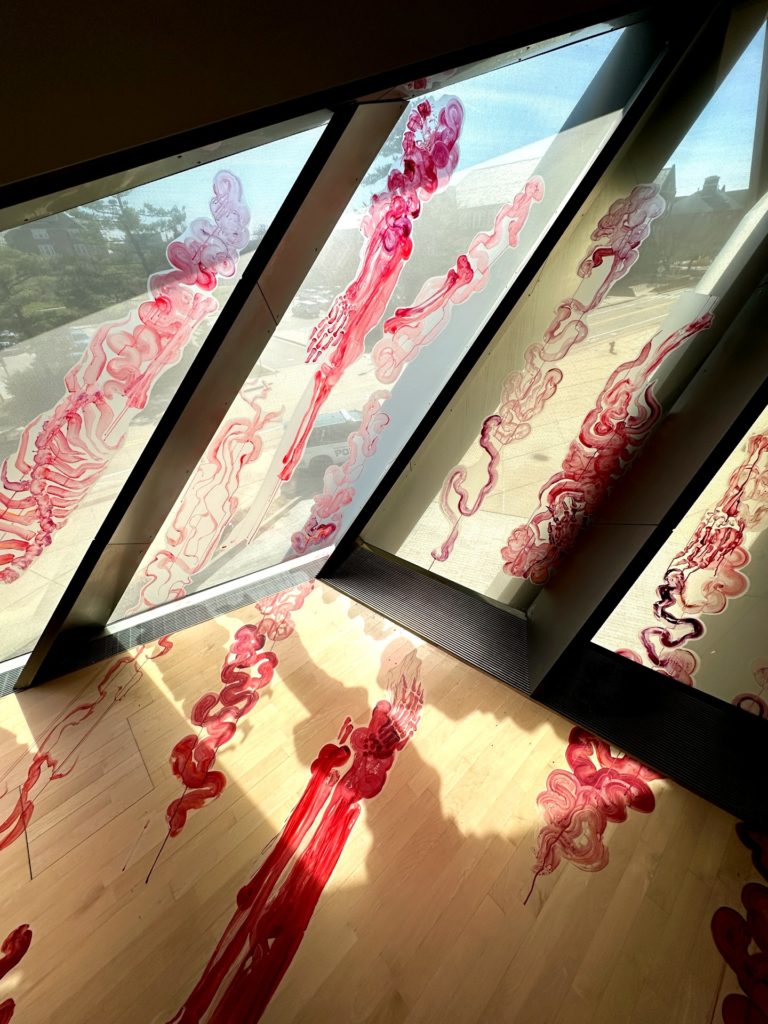As an interdisciplinary artist, animator, and immersive experience designer, Adeline Newmann weaves narratives that challenge perceptions and delve into the depths of human experience.
Her own artistic journey has been a flurry of unique experiences. Before pursuing an MFA at Michigan State University, her career ranged from VJing the dark corners of goth clubs to designing animation and visuals for music festivals. Her most recent position was as a Video Media/VFX Designer for theme parks across the United States and Asia.

She’s now a recent Michigan State University graduate, having received her MFA in Spring 2024 from the Department of Art, Art History, and Design, and her thesis project, Corrupted Uncorrupted, is now on display at the MSU Broad Art Museum as part of the 2024 Master of Fine Arts Exhibition that runs through Sunday, May 26. This thesis project showcases Newmann’s drawings from a variety of places, including the Crypt of the Capucchin Monks in Rome and the Mütter Museum in Philadelphia — both places where photography isn’t allowed, but drawing is.
Her creative workflow used in the making of Corrupted Uncorrupted involved two separate paths that converge during the making process. The first path involves immersive sketchbooking sessions, where she draws inspiration from real-world observations.
“Observational drawing is an incredibly powerful way to engage deeply with research, history, and collections,” she said.

The second path is experience design, where Newmann envisions how viewers will engage with her art.
“This includes considering how a person might move through the exhibit space and what creative technologies might be used in the final exhibit design,” she said. “I follow both of these paths and bounce them off one another at key intervals. Eventually, they converge in the final piece.”
Laden with profound themes and poignant narratives, Corrupted Uncorrupted dismantles the binary notions of health and illness and delves into the annals of misogyny within the history of medicine.
“I hope mostly that visitors will come away from ‘Corrupted Uncorrupted‘ with a wonder and respect for the human body, both as ‘specimen’ and as ‘person,’ and a renewed desire for health care access for all.”
“I’m fascinated (and horrified) by the stories about illnesses and myths about who can get sick and who cannot, the evolving narratives around cervical cancer and HPV-related cancers, and the true horror that people die all the time from these preventable cancers because of vaccine misinformation and lack of access to healthcare,” Newmann said.
Translating complex concepts into visual form is a challenge Newmann takes a unique approach to. Drawing from her visual research and literary exploration, she seeks to create a symbiotic relationship between internal narratives and external stimuli.

“I use my visual research and sketchbooking and also reading to help with this,” she said. “In my experience, I’ll have an internal concept and narrative cluster that functions as a guide, and I seek out places, collections, and other things and when one matches or dialogues with the internal concept/narrative, then I draw it to ‘collect’ it. These drawings become ‘concept design’ and sometimes also final pieces of the final exhibit.”
Experimentation is foundational to Newmann’s artistic process, rooted in experimental cinema and animation.
“I know that an experiment is successful when the emotion or idea I have inside connects with the feeling I get from the experimentation/artwork,” Newmann said. “The process itself is a lot of iterating and adjusting until suddenly it’s there.'”

(Photo by Adeline Newmann)
As Newmann researched her thesis project, she found a tangled web of ideas and stories that ultimately didn’t tell the whole story without the rest of their interconnected entanglements. This was the structure she wanted the exhibit to reflect.
HR Giger is a long-time influence, which is apparent in Corrupted Uncorrupted. His history of creating both production design for cinema and fine art is especially important for Newmann.
“Giger builds worlds with his art and design,” Newmann said. “For me, art making is more about building a world and inviting the audience to step in and spend some time in it. “
“For me, art making is more about building a world and inviting the audience to step in and spend some time in it.”
Newmann hopes to provoke introspection and dialogue in navigating the balance between personal expression and audience interpretation. Her artworks, ranging from abstract to representational, serve as conduits for individual reflections.
“My hope is that the more representational elements (falling figures, disarticulated bodies, etc.) anchor the theme or ‘world’ of the piece while the more abstract elements (bodily textures and colors) offer a suggestive Rorschach for the audience to read into and meditate on,” Newmann said.
Newmann also hopes to instill a sense of wonder and empathy in viewers of Corrupted Uncorrupted.

“I hope mostly that visitors will come away from Corrupted Uncorrupted with a wonder and respect for the human body, both as ‘specimen’ and as ‘person,’ and a renewed desire for health care access for all,” Newmann said. “And for any visitor who is on a journey through illness, I hope the show is a reminder that we are not alone in these journeys, no matter how scary or uncertain the path is ahead.”
Reflecting on her MFA journey, Newmann emphasizes the importance of time and space for artistic exploration.
“We live in an incredibly fast-paced world, and the opportunity to slow down, think, and make is such an important one,” she said.
Looking beyond the MFA program, Newmann envisions her artistic practice as an ever-evolving journey. Her thesis project doesn’t mark an endpoint but a genesis of further exploration into further interconnected stories.
For more information on the MFA Exhibition, see the 2024 MFA Exhibition web page.


